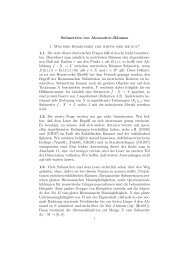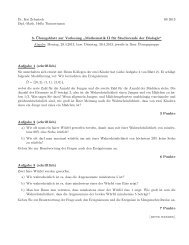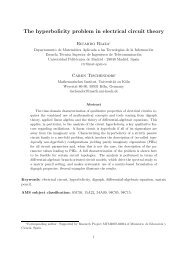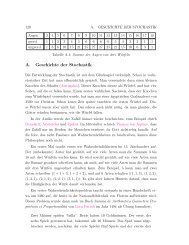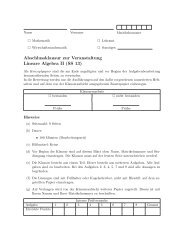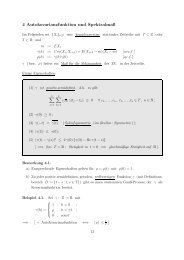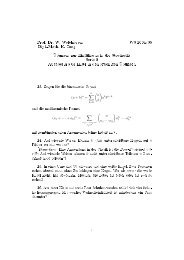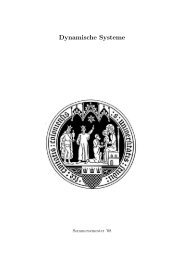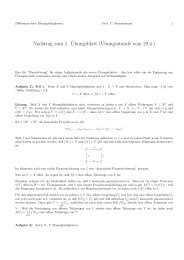Inhaltsverzeichnis - Mathematisches Institut der Universität zu Köln
Inhaltsverzeichnis - Mathematisches Institut der Universität zu Köln
Inhaltsverzeichnis - Mathematisches Institut der Universität zu Köln
You also want an ePaper? Increase the reach of your titles
YUMPU automatically turns print PDFs into web optimized ePapers that Google loves.
DMV Tagung 2011 - <strong>Köln</strong>, 19. - 22. September<br />
Veera Katharina Menz<br />
Deutsches Primaten Zentrum Göttingen<br />
Modelling of Synaptic STDP and Analysis in a Two-Neuron Model<br />
Synapses as the connecting elements between two brain cells are crucial in transmitting electrical signals<br />
from one neuron to another. Donald Hebb postulated in 1949 that the transmission of signals between<br />
two cells can be improved due to synaptic modification when both cells are active at the same time or<br />
shortly after each other. Additionally, Bi and Poo detected in 1998 that the strength of transmitting signals<br />
can also decrease, depending on the relative spike-timing of the connected cells (spike-timing-dependent<br />
plasticity, short STDP).<br />
We will discuss a mathematical model which describes the behaviour of spiking neurons and synaptic<br />
weight change of connecting synapses in terms of spike-timing-dependent plasticity. By combining an<br />
integrate-and-fire equation with a system of differential equations as a modification of a model of STDP by<br />
Gorchetchnikov, Versace, and Hasselmo (2005) an STDP-curve is produced similar to the one found experimentally<br />
by Bi and Poo (1998). This mathematical model is applied to two coupled neurons stimulated<br />
by a constant external current and examined for long time periods both for permanent external stimulation<br />
as well as short initial stimulation. The results are compared to data of in vivo and in vitro neurons.<br />
Literatur<br />
Bi, G., & Poo, M.-M. (1998). Synaptic Modifications in Cultured Hippocampal Neurons: Dependence on<br />
Spike Timing, Synaptic Strength, and Postsynaptic Cell Type. Journal of Neuroscience, 18(24), 10464 -<br />
10472.<br />
Gorchetchnikov, A., Versace, M., & Hasselmo, M. E. (2005). A mode of STDP based on spatially and<br />
temporally local information: Derivation and combination with gated decay. Neural Networks, 18, 458 -<br />
466.<br />
Hebb, D. O. (1949). The Organization of Behaviour: A Neuropsychological Theory. New York: Wiley.<br />
Ralf Müller<br />
Department of Psychiatry and Psychotherapy, University of Cologne<br />
Modelling coupled network oscillations to study structures in real electroencephalogram<br />
(EEG) data as part of a multifaceted approach for the detection of psychiatric diseases<br />
In medical science, the electroencephalogram (EEG) gives an impression of the dynamics of cortical<br />
brain functions in humans and is used to investigate neurological and psychiatric diseases. Diverse<br />
mathematical methods, e.g. time-frequency methods, are very helpful in disentangling the complexity of<br />
the EEG data and thereby contribute to a better un<strong>der</strong>standing of neurobiological differences between<br />
diseases. Since microscopic and macroscopic neuronal circuits play a key role in un<strong>der</strong>standing complex<br />
psychiatric diseases, e.g. schizophrenia, different approaches in the field of mathematical modelling are<br />
applied. We describe, how analyses and simulations of our neurophysiologically based coupled phase<br />
oscillator model allow new insights into temporal dynamics of sensory processing, which can be detected<br />
in real EEG data in humans.<br />
170




